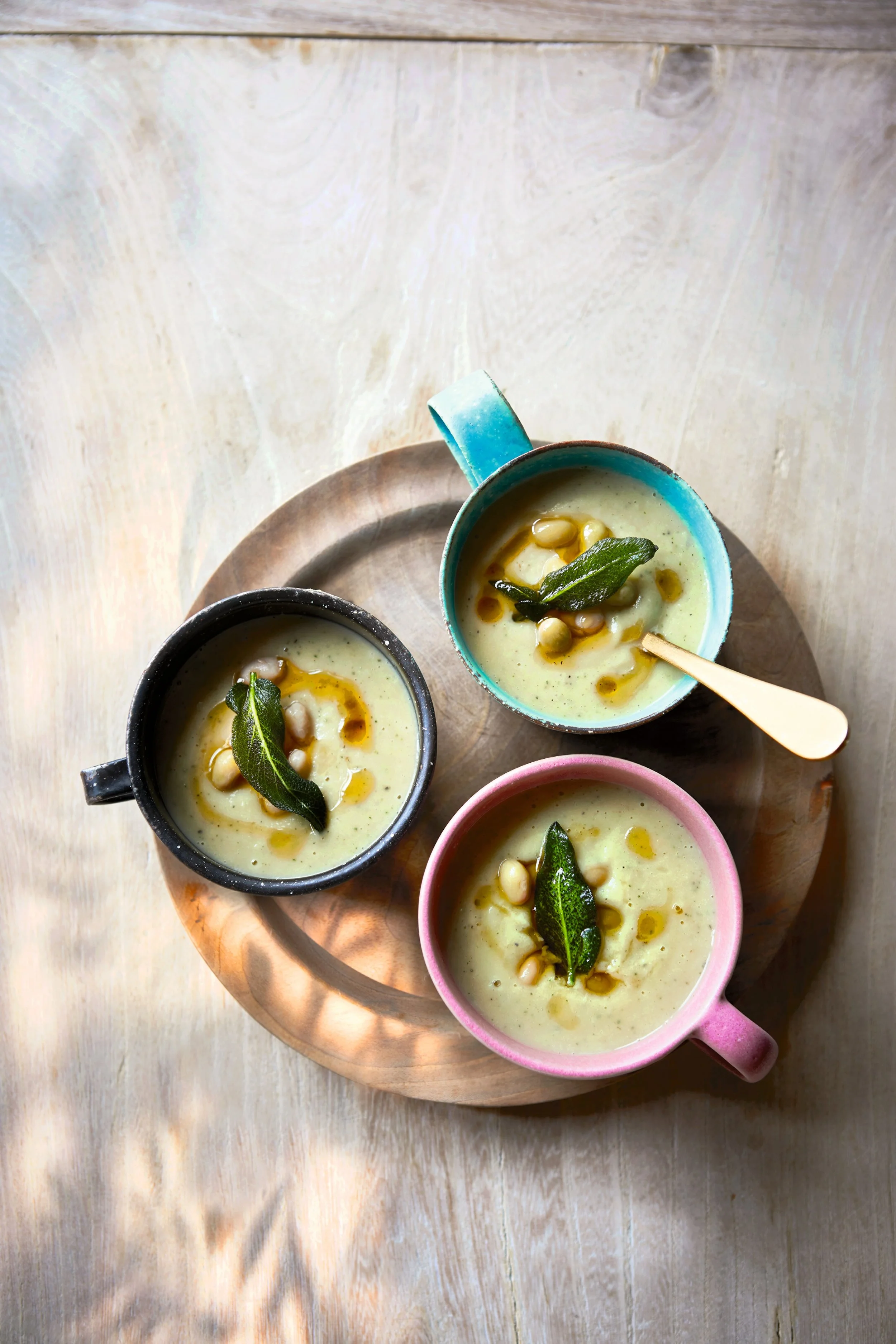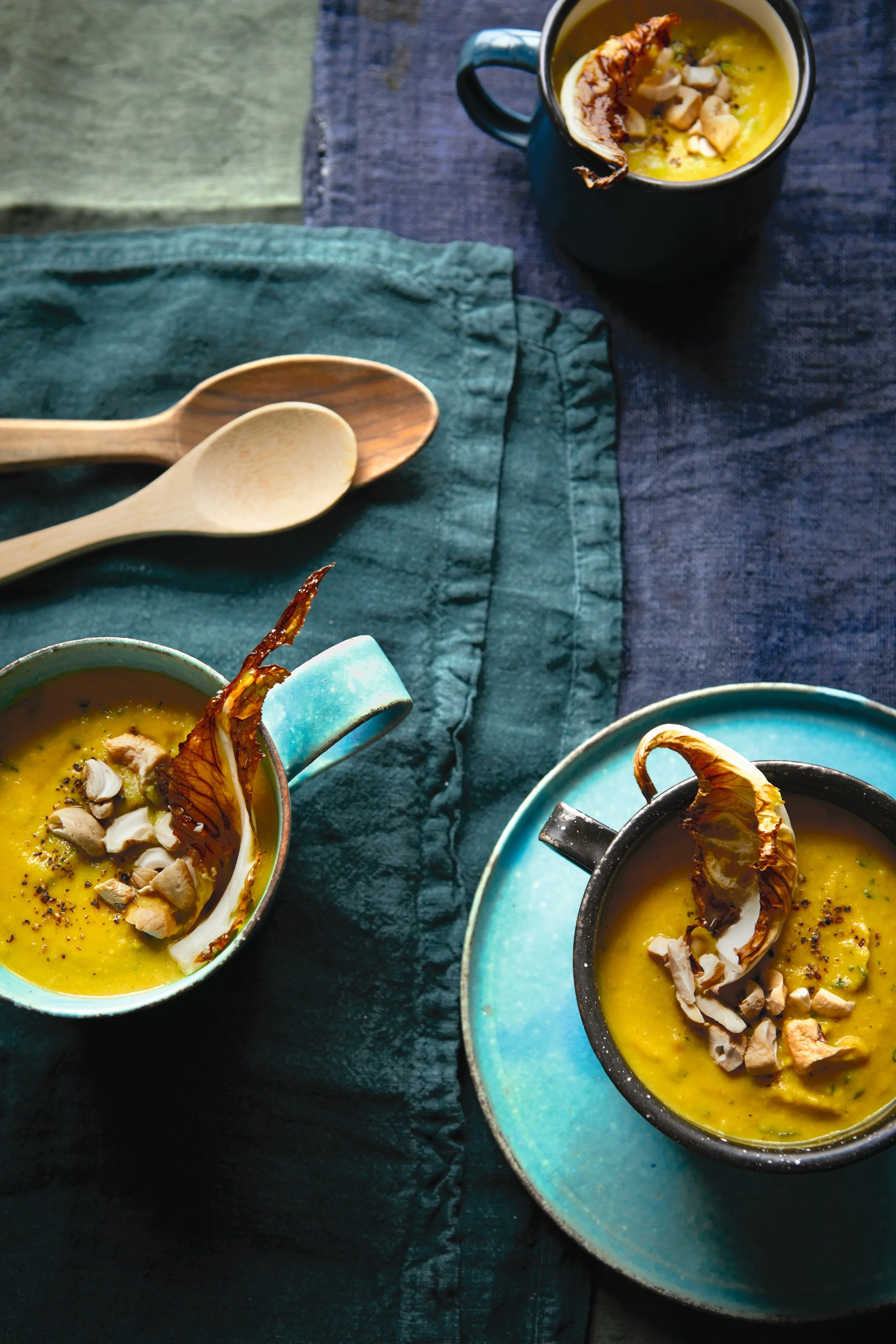Rachel Allen - Soup & Bread
Best selling cookery writer and TV chef Rachel Allen teaches at the renowned Ballymaloe Cookery School in Co Cork.
She has written 14 hugely successful cookbooks, which have sold over a million copies worldwide and she is a regular host and contributor to TV programmes for the BBC and RTÉ, including The Restaurant, Rachel’s Favourite Food, Bake, Easy Meals, Cake and Rachel’s Everyday Kitchen have been broadcast in over 30 countries.
Soup is one of the most versatile dishes, whatever the season and particularly so in Ireland where wholesome warming recipes keep the winter chill at bay. Packed with Rachel’s trademark know-how, wisdom, tips and advice, Soup Broth Bread is accessible to home cooks of every level. It also features recipes for homemade breads, garnishes and stocks, and a wealth of tips on equipment, batchcooking, freezing and presentation.
Ballymaloe Cookery School Focaccia
SERVES 10–12
“This is the focaccia that we make at the Ballymaloe Cookery School, a recipe devised and tweaked over time by my father-in-law, Tim. The secret of a super-light Italian focaccia is to incorporate enough water into the dough, which is why it is added in increments in this recipe, allowing for the gluten in the flour to be developed before more water is added. We always teach our students to weigh the water for this recipe to get exact measurements, because if a little bit too much liquid goes in with each addition of water, the dough will just end up too wet.
This particular recipe works best using a stand mixer and dough hook – however, if you don’t have one, you can make it by hand but it’ll take some time and patience to get it to the right stage.
The original Italian bread was simply sprinkled with flakes of sea salt, but we often add a couple of teaspoons of chopped rosemary, thyme or sage over the top of the focaccia with the sea salt flakes before baking, and, if you wish, about 15 pitted olives can also be added, though it’s worth pressing them down into the dough so they stick. Sometimes when a freshly baked focaccia is taken from the oven, it gets drizzled with another glug of extra virgin olive oil. I feel it’s not necessary with this recipe, but do so if the mood takes you."
INGREDIENTS
◆ 600g lukewarm water (see above)
◆ 15g caster sugar
◆ 20g fresh yeast, or 10g dried yeast 2 tablespoons extra virgin olive oil, plus extra for drizzling into the bowl and the tray
◆ 700g strong white flour 2 teaspoons salt sea salt flakes
METHOD
➊ Place 150g of the lukewarm water in a bowl or measuring jug and stir in the caster sugar. Add the yeast and set aside for 3 minutes. Add the olive oil and another 300g of lukewarm water.
➋ Place the flour and salt in the bowl of a stand mixer fitted with the dough hook, and mix together. Make a well in the centre and pour in the yeast mixture. Mix to a dough – this will take approximately 5 minutes.
➌ Add half the remaining lukewarm water (75g) and continue to knead, using the dough hook, for another 5–6 minutes until it comes together again, then add the remainder of the lukewarm water (75g). Continue to knead for another 6–10 minutes until the dough becomes soft, silky and stretchy – it should now be coming away from the sides of the bowl.
➍ Pour the dough out onto a clean, damp work surface for ‘bench rest’. Gently fold the dough from each side into the centre like a parcel. Rest for 5 minutes. Repeat twice more, resting for 5 minutes each time.
After you have folded the dough the third time, transfer it to a bowl oiled with olive oil (you can use the bowl of the stand mixer again). Cover the bowl with a clean tea towel, set aside in a slightly warm part of your kitchen, and allow the dough to rise until it is about doubled in size, approximately 1–2 hours.
The rising time will depend on the temperature of the water, the room and the freshness of the yeast being used. You can slow down this stage by placing the covered bowl in the fridge, where it’ll take approximately 8–12 hours to rise. If I want to make the dough and bake the focaccia the following day, I will use all room temperature water instead of lukewarm water and place it in the fridge overnight.
➎ Preheat the oven to 230°C/210°C fan/gas 8. You need a small deep roasting tin, measuring 32 x 23cm and 5cm deep. If you wish, you can line the tin with parchment paper – the base and up the sides too – just to ensure that the dough won’t stick. Either way, brush the tin or the paper with olive oil.
➏ When the dough has doubled in size, pour it from the oiled bowl into the oiled roasting tray, gently so as not to knock any air from the dough. Drizzle a little extra virgin olive oil over the top, and dimple the dough with your fingertips. Set aside somewhere nice and warm (but not above 40°C) for 15–20 minutes, to rise a bit more. Sprinkle with sea salt and cook in the preheated oven for 10–15 minutes, then reduce the temperature to 200°C/180°C fan/gas 6 and bake for a further 10–15 minutes.
➐ Remove from the tin and return to the oven, directly on the oven rack, for 5 minutes approximately, until light – it should sound hollow when tapped. Cool on a wire rack
Roasted Parsnip, Garlic And Haricot Bean Soup With Sage
“This is a supremely smooth and silky soup, topped with deliciously crisp fried sage leaves. The garlic cloves, when roasted in their skins, deliver a sweet but rounded depth that I adore. A perfect soup for a cold blustery day”.
INGREDIENTS
◆ 3 medium or 2 large parsnips, peeled and cut into 2cm chunks
◆ 1 large onion, peeled and cut into
◆ 2cm chunks
◆ 6 very large, whole unpeeled cloves of garlic (40g in total)
◆ 2 tablespoons extra virgin olive oil
◆ salt and freshly ground pepper
◆ 1 x 400g tin of haricot beans*
◆ 1 litre vegetable or chicken stock
◆ 1 tablespoon chopped sage
METHOD
➊ Preheat the oven to 200°C/180°C fan/ gas 6. Place the parsnip and onion chunks in a roasting tray with the whole unpeeled cloves of garlic. Drizzle over the olive oil and toss the vegetables, seasoning with salt and pepper. Spread them out to cover the base of the roasting tray and place in the preheated oven for 35–45 minutes, until the vegetables are tender and a little golden around the edges.
➋ Drain the tin of beans and tip all but a generous tablespoon of beans into the vegetables. Return to the oven for 5 minutes more.
➌ Take the tray out of the oven and tip the beans and vegetables and any delicious juices into a saucepan with the hot stock.
Add the 1 tablespoon of chopped sage and blend the soup until smooth and silky. Season to taste.
TO SERVE
◆ 2 tablespoons extra virgin olive oil
◆ a handful of sage leaves
➊ Pour the hot soup into warm bowls. Put the 2 tablespoons of olive oil into a small frying pan and allow to get hot. Add the sage leaves and fry for 10–15 seconds, until they turn a couple of shades darker and become fragrant. Spoon the sage flavoured oil and the crispy sage leaves over the soup with the reserved beans, and serve straight away.
*If you’re cooking dried beans from scratch, you’ll need 125g of haricot (or cannellini) beans. Soak in plenty of cold water overnight or for at least 5 hours, then drain, cover with plenty of fresh cold water and boil for 30–40 minutes, until tender.
Cauliflower, Cashew And Coriander Soup
“This smooth and creamy golden bowl of goodness gets its silky texture from cashew nuts and its soothing anti-inflammatory benefits from the yellow turmeric. Serve on its own, or with toasted cashews scattered over the top”.
SERVES 6
INGREDIENTS
◆ 1 cauliflower head
◆ 3 tablespoons extra virgin olive oil 1 large onion (200g), chopped
◆ 4 large cloves of garlic, chopped 100g cashews
◆ 1 tablespoon ground turmeric
◆ 1⁄2 teaspoon freshly ground black pepper
◆ a few good pinches of salt
◆ 1.1 litres vegetable or chicken stock (see pages 277, 264)
◆ 2 tablespoons lemon juice
◆ 4 tablespoons chopped coriander (leaves and the fine stalks)
FOR THE TOASTED CASHEWS
◆ 20g cashews
METHOD
➊ First, prepare the cauliflower. Remove and discard the outer green leaves, reserving any smaller ones close to the cauliflower, and cut off and discard the base of the stem. Cut the cauliflower into slices, then chop it all: florets, stalks and any remaining leaves.
➋ Place the olive oil in a saucepan over a medium heat and add the cauliflower, the chopped onion and garlic, the cashews and the turmeric. Season with the pepper and a few good pinches of salt (this soup needs careful seasoning, otherwise it can be bland).
➌ Cover the vegetables with the saucepan lid, then turn the heat down to low and cook, stirring from time to time, for about 15–20 minutes, until the vegetables are tender.
➍ While the vegetables are cooking, toast the cashews. Place them in a dry frying pan over a medium heat and toss them regularly for about 4 minutes, until golden. Roughly chop and set aside.
➎ Add the stock to the vegetables and bring to the boil, then blend the soup well. Add the lemon juice, chopped coriander and more salt and pepper if necessary. The soup should be smooth, like velvet.
➏ Serve the soup straight away or reheat, and scatter the toasted cashews over the top









